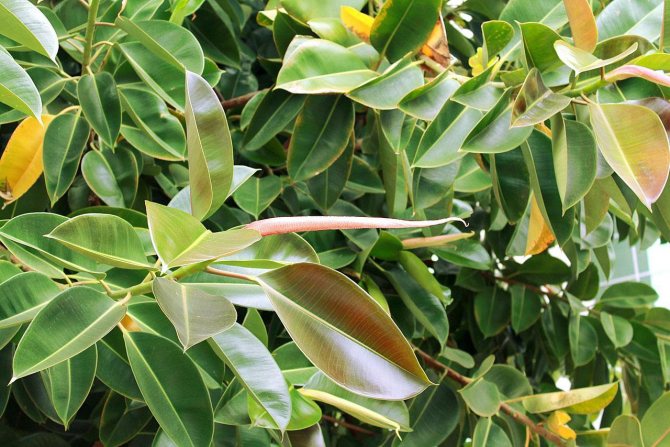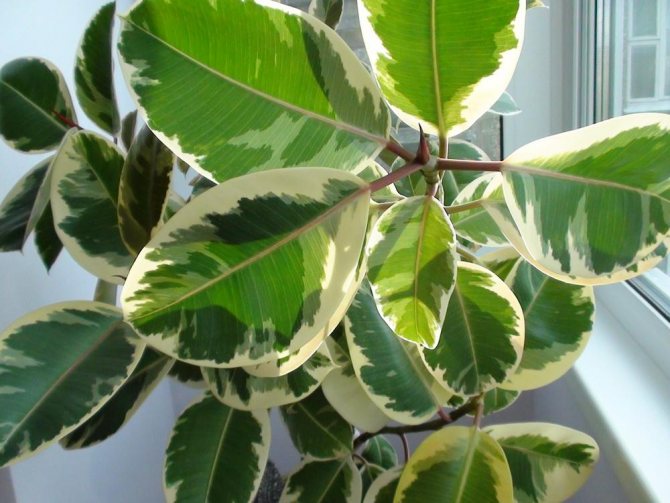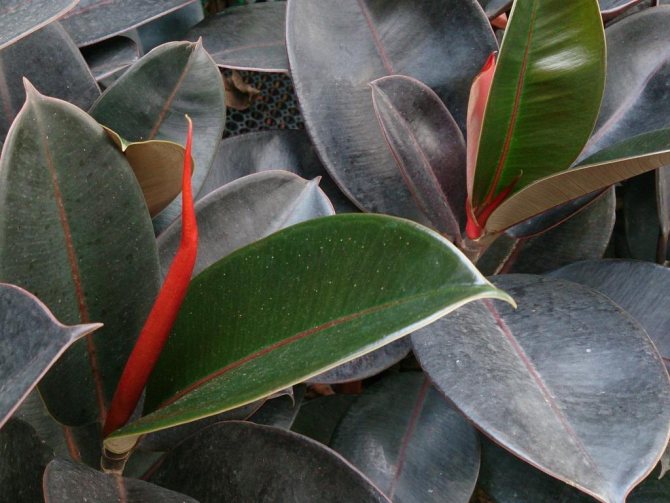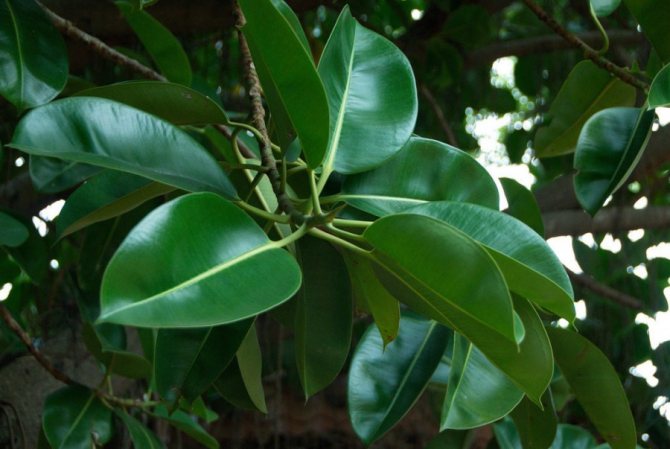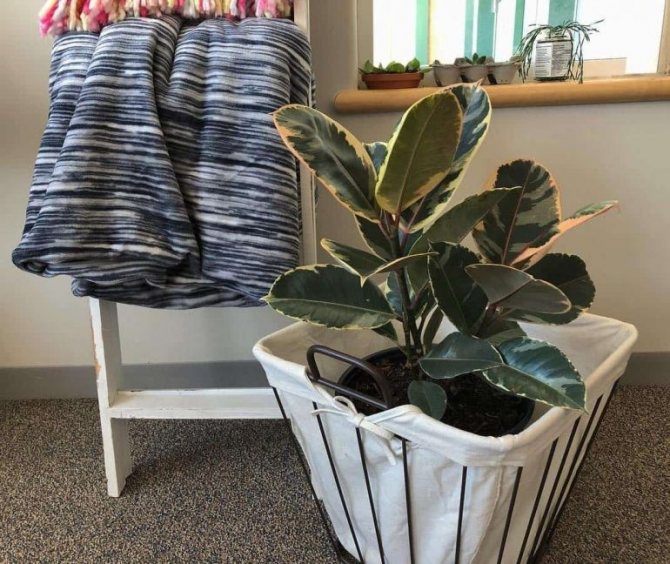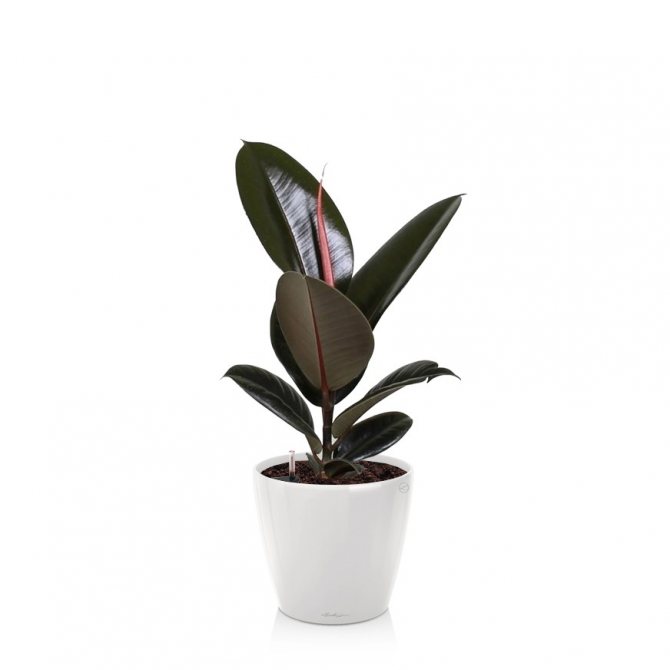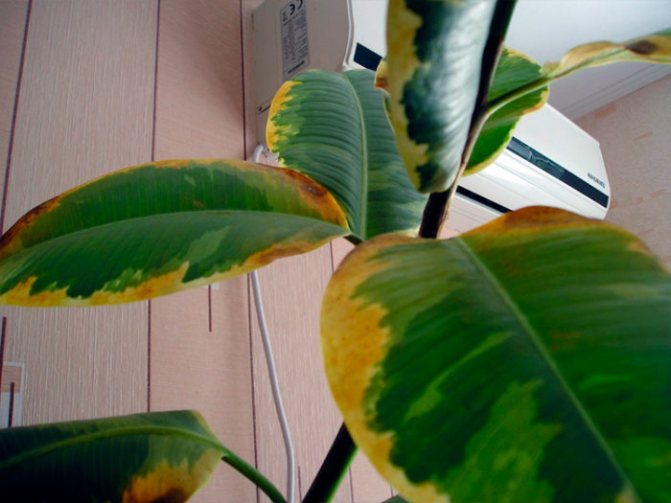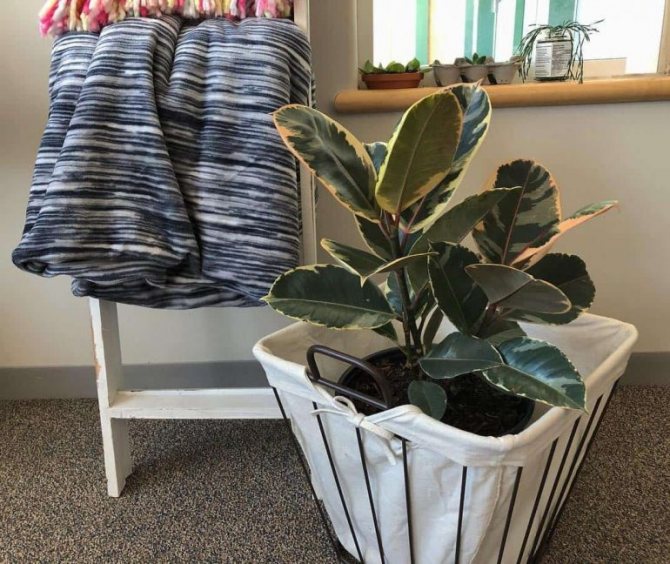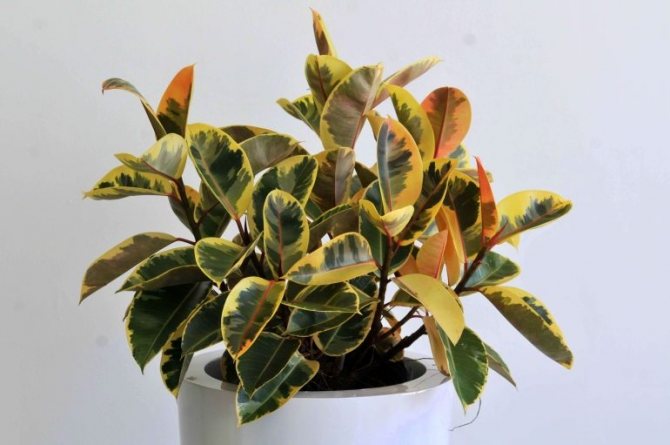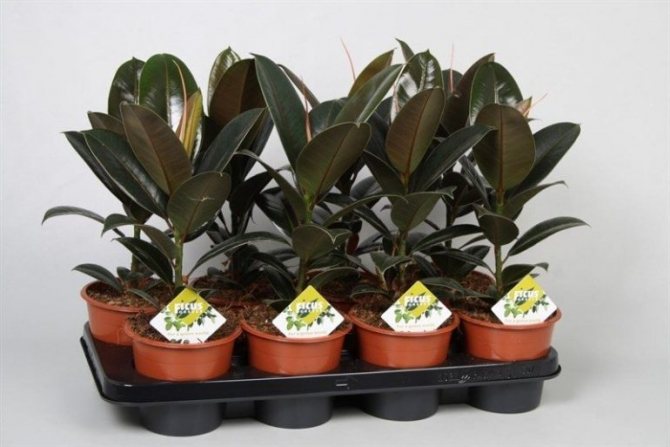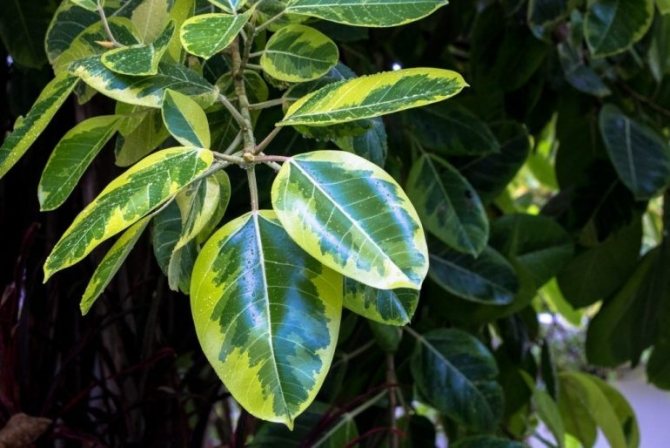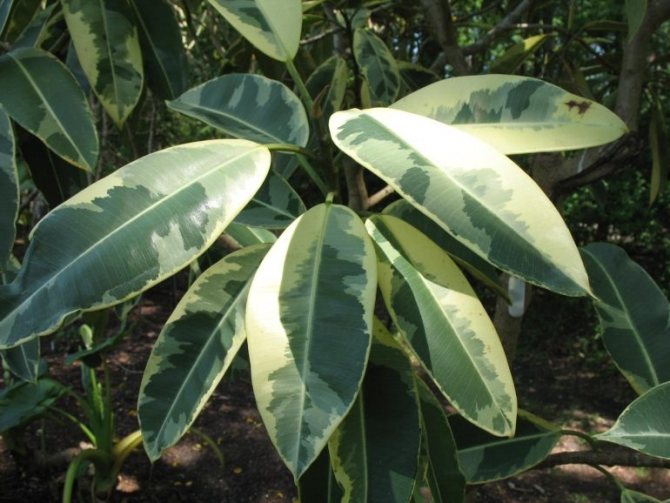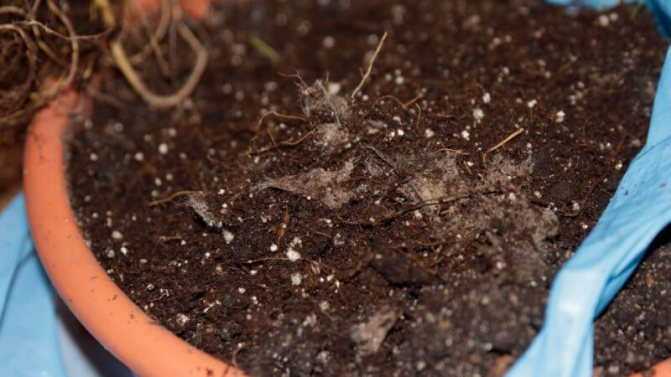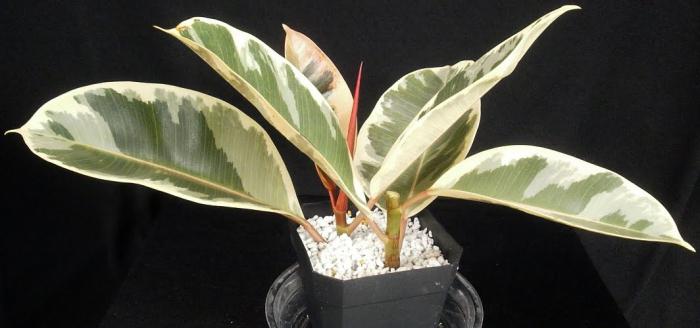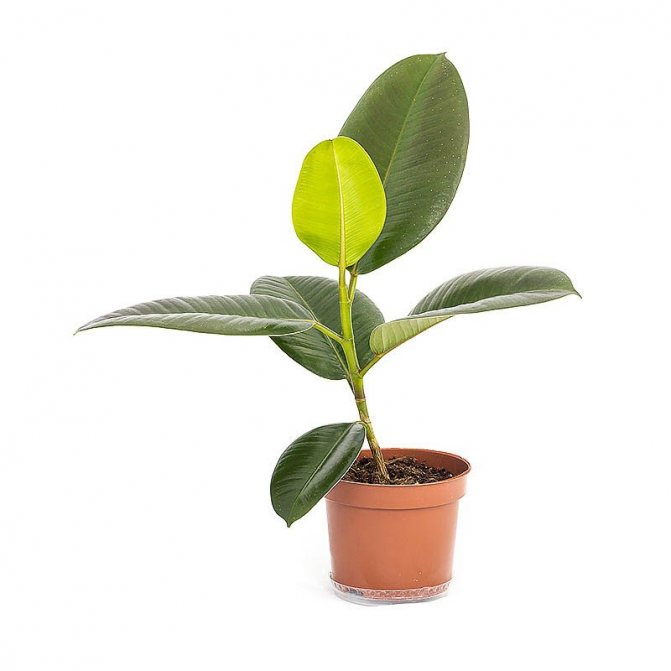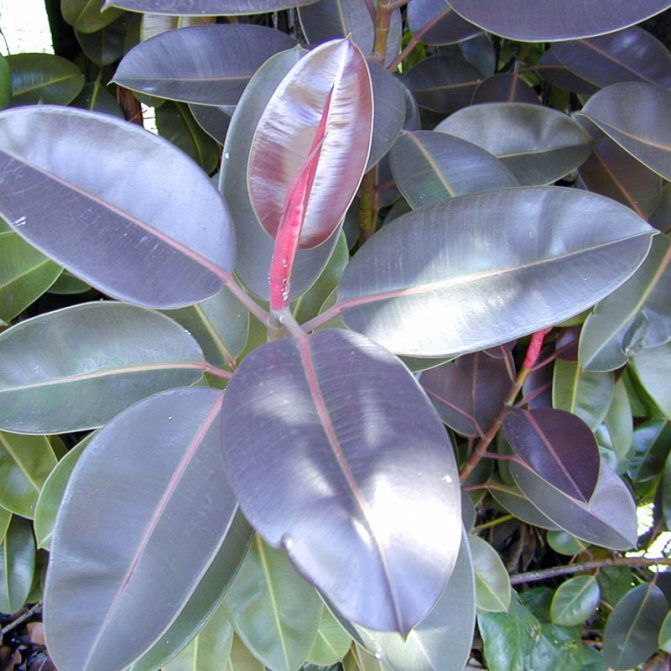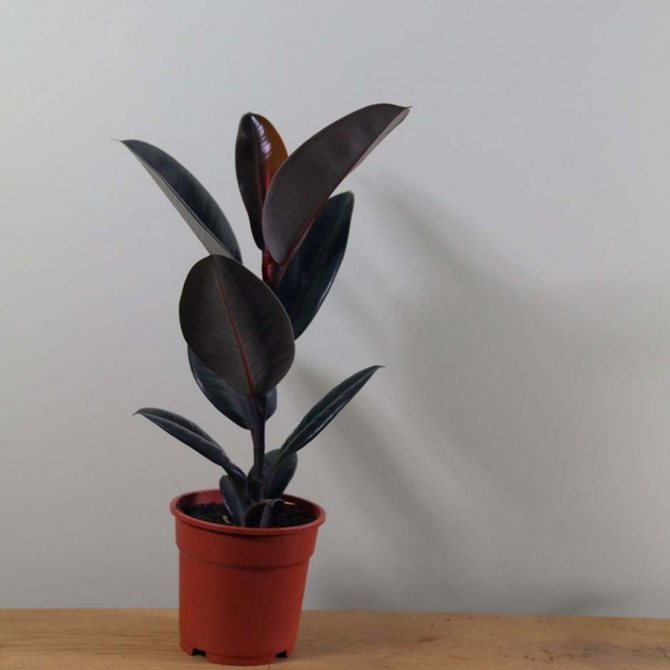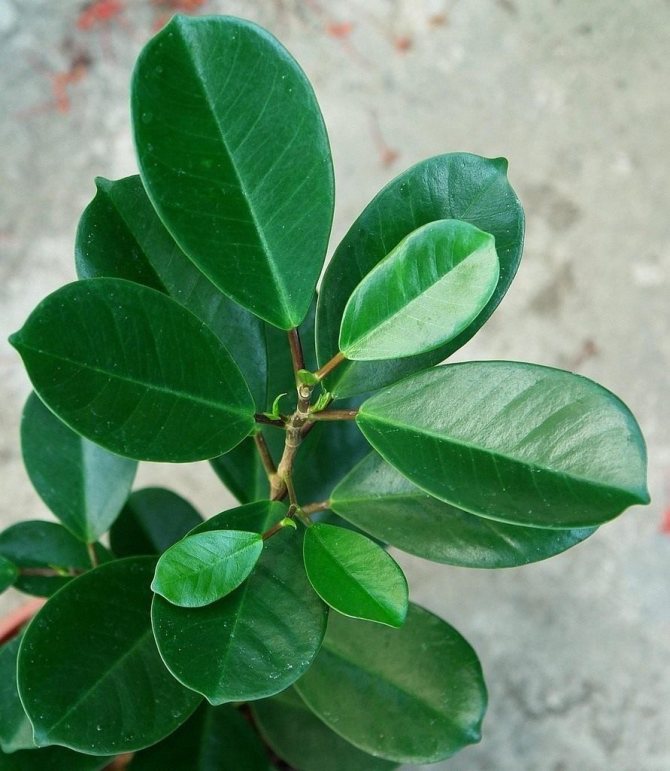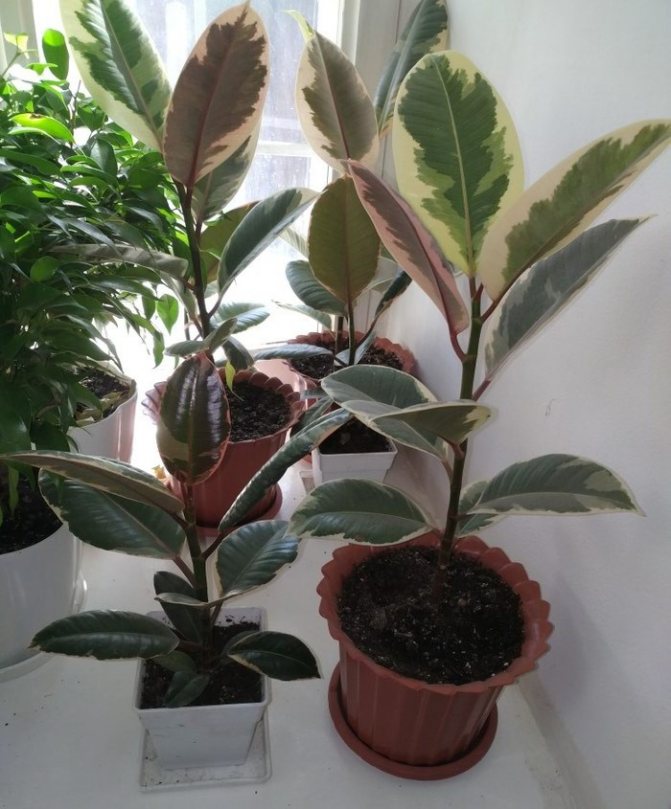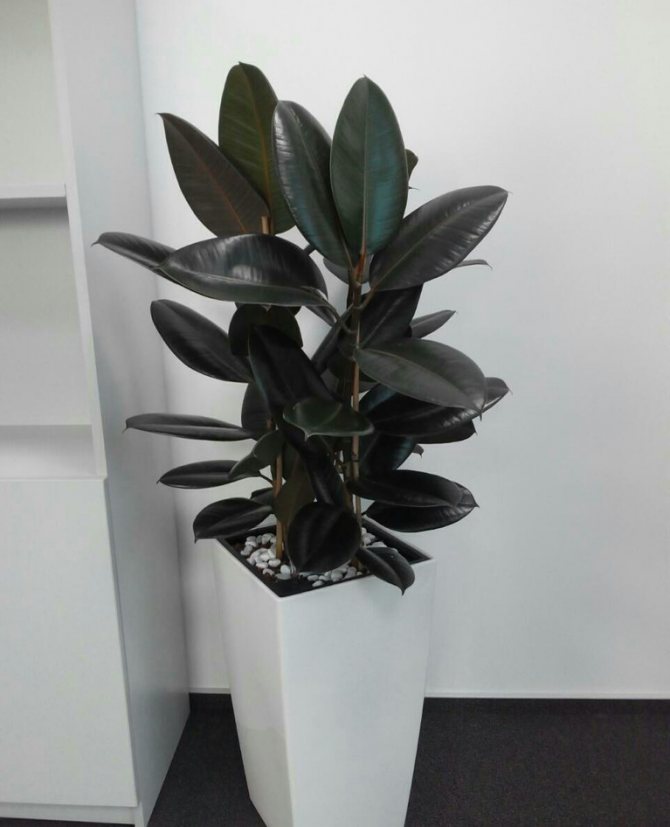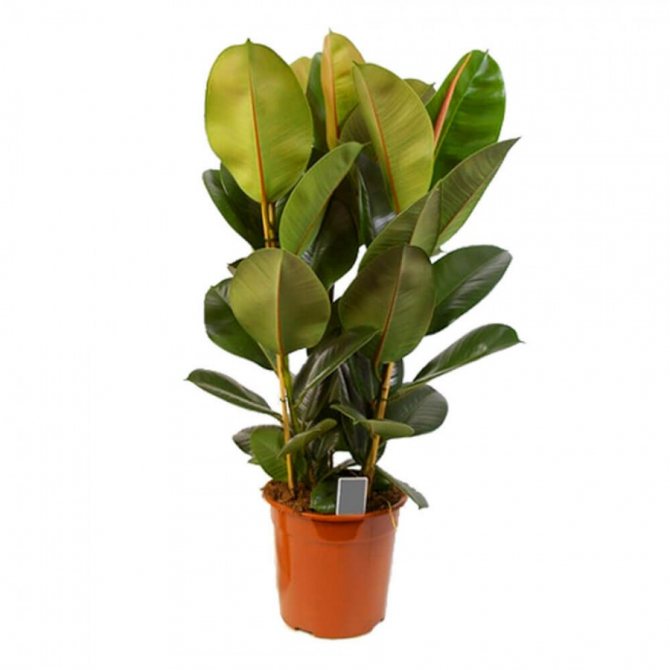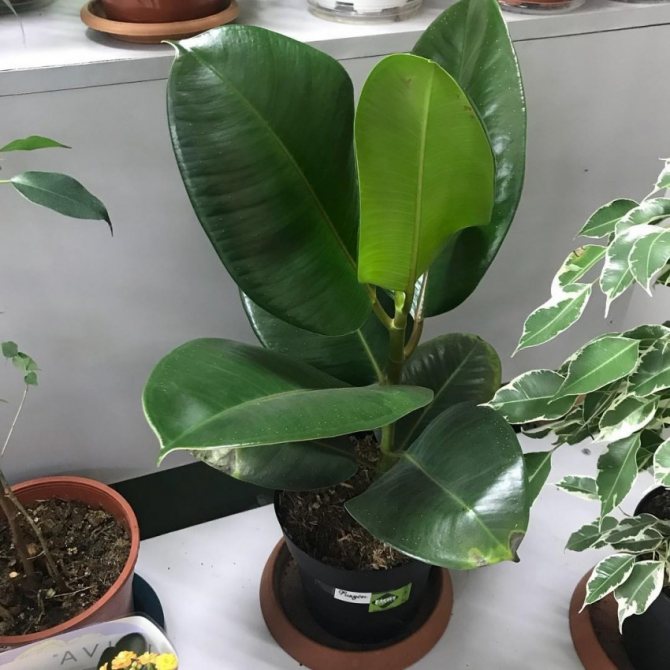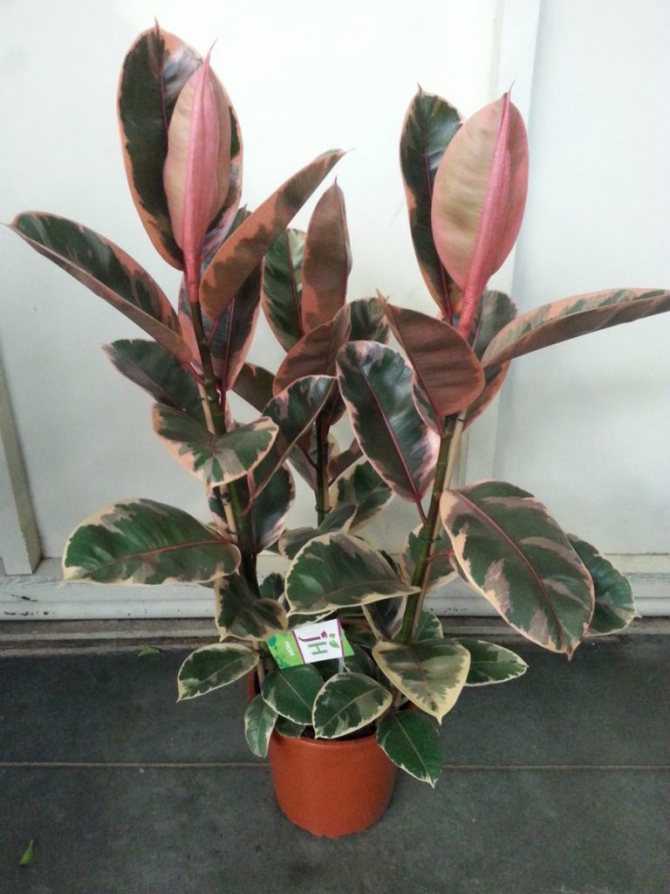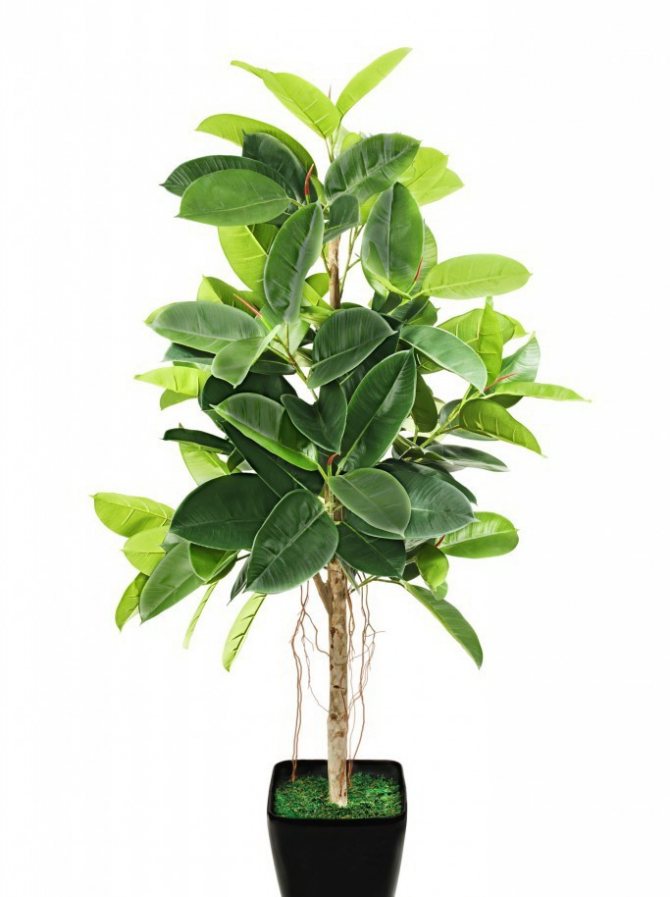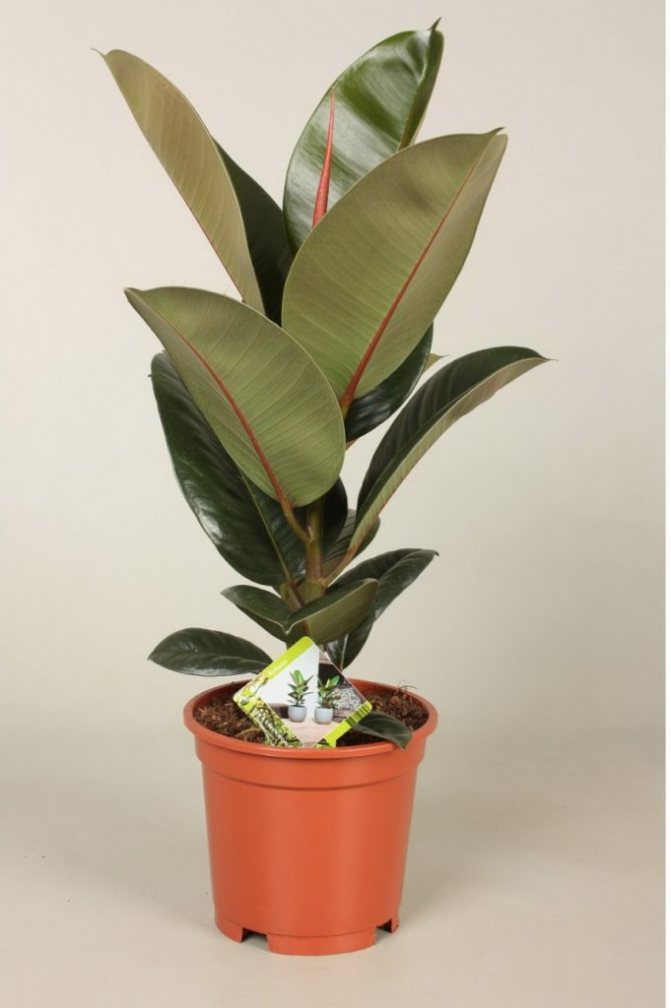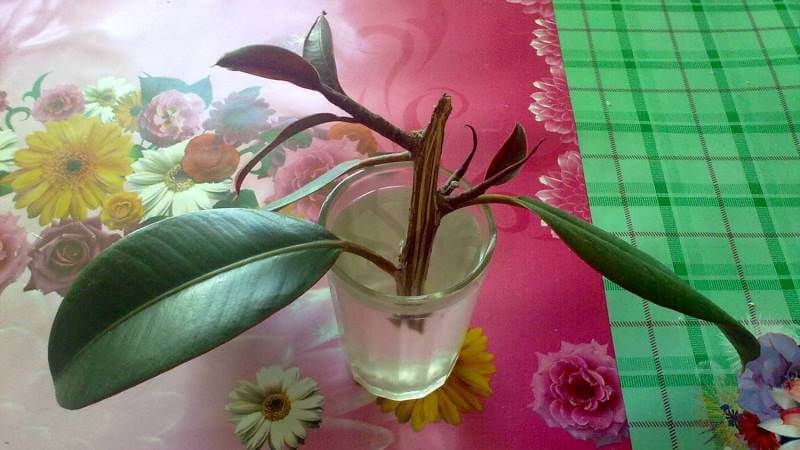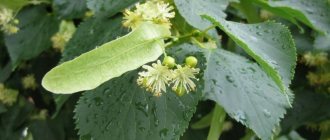Ficus elastica or rubbery is a common potting crop. This plant has been considered a symbol of family well-being since ancient times.
It is an evergreen native to southern Indonesia and northeastern India, where it can grow up to 30 m.
At the first stages of development, the ficus has one unbranched trunk. According to the degree of development, aerial roots appear on the branches and trunks, which in a warm and humid environment, when they reach the ground, form a banyan tree and new trunks.
Ficus leaves are large elliptical in shape, have pointed ends. They are located alternately. Young leaves and stipule are dark brown. The flowers are pollinated by certain insects.
Milky sap often appears on the leaf plate. Ficus was once grown for production rubberwhere its name comes from.
What is the use and harm of ficus? This plant has a beneficial effect on the indoor microclimate, cleans the air from harmful benzene, trichlorethylene and phenol. They are converted into sugars with amino acids.
In Indian medicine, Ayuveda ficus is recommended to improve the energy of a room, to clear it of anxiety and anxiety. It is a harmless plant that needs to be cared for properly.
The appearance of rubber ficus
Immediately, we will make a reservation that you can meet with different names of this plant: rubbery, rubbery or elastic. Both names can be applied and are correct. Theoretically, rubber ficus, which is home to India and Indonesia, can grow up to 30 m in height.Since it is not possible to keep a plant of this size at home, you will have to devote time to such procedures as pruning and shaping. Rubber ficus grows not only in height, but also in width. So-called aerial roots appear on its trunk and branches, which, reaching the ground, begin to receive nutrients from it.
The leaves of the rubber ficus are large, elliptical with pointed ends. Each leaf is painted in a rich and deep green color. A feature of the plant is that the leaves have a glossy surface. Often, near young leaves, which are rolled into a tube, there is a stipule of a reddish color. But as soon as the young leaf opens, the stipule falls off.
Many are interested in the question of how the rubber-bearing ficus blooms, and whether it blooms at all. This plant blooms, but only if it has been pollinated by certain insects. Accordingly, with room maintenance, flowering is almost impossible. But this is also a small loss, since the flower that appears after pollination has no unusual beauty, as can be judged by its photo.
Description of ficus elastica
The plant, in its natural environment, reaches a height of 40 m, when grown indoors it grows up to 10 m, but this is a rare case, as a rule, the height is no more than 1 m.
The leaves of the tree are a glossy oval with a pointed end, rather large (up to 30 cm long). At a young age they are pinkish-brown, at an old age they are dark green.

Fruits are yellow-green, oval, with a diameter of 1 cm. At home cultivation, the flowering of ficus is very rare.
Plant features
A feature of rubber ficus is the chemical composition of its milky juice. It contains rubber that can be used to make rubber. As a matter of fact, it was thanks to this feature that at one time this plant gained wide popularity. Now it is kept mainly for beauty.
It is also worth noting that in rubbery ficus, milky juice contains substances that can cause irritation on the skin or even an allergic reaction. Therefore, a procedure such as pruning or transplanting a ficus must be done very carefully. It is advisable to wear gloves on your hands. Despite the fact that for humans, milky juice is to some extent dangerous, the plant needs it in order to heal wounds inflicted by people.
Despite the fact that in the wild, the height of a rubber-bearing ficus reaches 30 meters, in an apartment it rarely grows above 200 cm.To get a taller plant that will decorate a greenhouse or winter garden, you need to properly monitor it and create certain conditions for the ficus ...
Characteristics of Ficus Belize
Ficus Elastica Belize belongs to the Mulberry family. Wide oval leaves grow up to 22-23 cm long and up to 13 cm wide. The leaf is compacted, leathery, with a glossy surface, sharpened in the upper part. The vein running in the center is well pronounced and burgundy in color. But the most interesting is the color of the foliage. In the middle, the leaf is rich green, along the edges of white-pink tones.
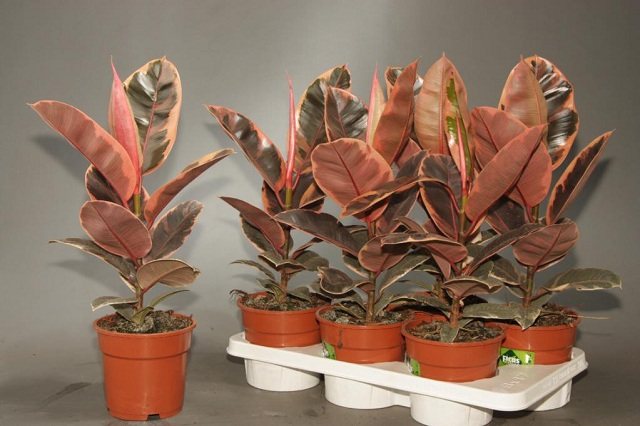

Pros of Ficus Belize
The pluses include the fact that Belize is one of the popular plants for home growing, as well as:
- high resistance to diseases and insect pests;
- unpretentious care;
- colorful, special, bright appearance.
Conditions for keeping ficus
Caring for rubber ficus at home involves maintaining a certain temperature and light regime. You also need to properly organize watering. When choosing a place for a plant, we take into account that the flower is photophilous. But, at the same time, direct sunlight negatively affects his health. If the leaves of the rubber plant turn yellow or brown spots appear, then first of all look for direct sunlight.
A shaded area, as too sunny, is not the best for rubbery ficus. With a lack of light, its leaves will begin to fade and fall off. In addition, a flower in partial shade will grow very slowly. Ideally, a diffused solar set should not fall on the plant.
As for the temperature regime, neither heat nor cold is critical for rubbery ficus. True, we are not talking about prolonged heat or cold. The optimal temperature is 230C. In winter, the air temperature can drop to 15-180C. It will not harm the plant. But below 150C, the thermometer should not fall.
Plant pruning rules
However, in the care and pruning of a ficus tree, certain rules must be followed. So, what do you need to know before pruning a ficus tree?
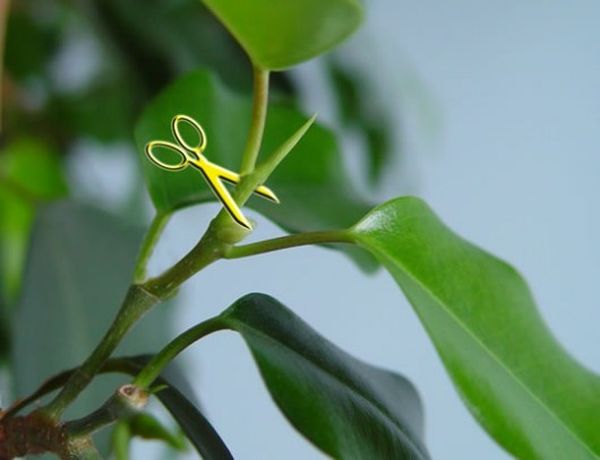

- The procedure is carried out in the spring, when the tree begins to grow actively.
- The height of the bush is also important - before performing the procedure for the first time, you must wait until it reaches a height of 70 cm.
- Choose tools that are sharply sharpened in order to precisely cut off the necessary elements of the plant, and not break them off. In addition, all instruments must be sterile - it would be best to treat them with alcohol before the procedure.
- Only the trunk is cut obliquely, and all thin shoots are cut in even cuts.
- The oblique incision begins above the kidney and exits on the other side at about its level.
- It is allowed to cut very thin branches with scissors, and not with a pruner or knife.
- Never prune branches immediately after transplanting - wait at least two weeks for the plant to be less stressed.
Watering features
Caring for a rubbery ficus involves watering the flower. The plant is not moisture-loving. Water the ficus as needed. The topsoil should not be constantly wet. After the top 2-4 cm of the soil has dried, we water it. On average, watering in a hot period of time is carried out no more than 2 times a week, in a cold period - 1 time a week. If the rubber plant begins to shed its leaves, then most likely you overdid it with watering.
In addition to watering, caring for rubbery ficus involves spraying a flowerpot and wiping the leaves. In summer, due to low air humidity, this should be done at least once every 2 weeks. In winter, this procedure can be omitted.
It is also advisable to periodically arrange bath procedures, namely a shower. To do this, put the plant in the bathroom, cover the ground with a plastic bag, and turn on the water. The water temperature should be 18-200C.
The plant does not tolerate the neighborhood with heating devices.
Ficus care at home. In detail
Homemade rubber ficus is considered unpretentious and grows well even among inexperienced growers. This tropical plant does not like drafts, prefers warmth and diffused light.
After purchase, it must be kept in quarantine for two weeks. During this period, the foliage should be examined for the presence of pests. For disinfection, you need to spill the ground with soap and water in order to destroy possible parasites.
If pests are found, they must be transplanted into another pot and treated with an insecticide. After the destruction of all parasites, the plant is transplanted into another pot.
Fertilization and flowering
The plant feels much better if it receives all the necessary organic and mineral fertilizers from spring to autumn. They must be introduced into the soil every two weeks. In this case, the ficus will delight its owner with beautiful flowers.
Cold wintering also affects flowering. After her, the plant wakes up and blooms.
Temperature
For good growth, the plant must be at a comfortable air temperature for it.
During the period from spring to autumn, the room should have an average temperature of 15-26 ° C.
In winter, a dormant period sets in and the plant feels well within the range from 8 ° C to 15 ° C.
Only variegated rubber ficus prefers normal room temperature.
Humidity
If you constantly maintain moderate air humidity, then the ficus will look great and delight the owner with green foliage. The plant loves a warm shower every couple of weeks. It is necessary to ensure that no water accumulates in the sheet funnel. Spraying should be done several times a week, and the leaves should be wiped as they become dirty.
Watering
An inexperienced owner needs to pay special attention to watering. It is very destructive, both the flooding of the soil and its drying out.
In the warm season, the plant is watered two to three times a week. The need is determined by the dried top layer... In winter, watering is reduced to one time - this is quite enough even for especially large specimens. It is extremely harmful to overdo it with watering in a cold room - it is detrimental to the root system.
Lighting
Indoor rubber plant prefers moderate lighting. It can grow in partial shade, but not so fast. Variegated forms are more demanding to care for - they need more light, they are much more thermophilic and tolerate low temperatures worse. According to experienced flower growers, plants with dark foliage require less light.
Ficus with dark green leaves can grow even in poorly lit areas. While the plant is young, do not put it close to batteries or in passages where drafts are possible.In some cases, this can be fatal.
Best home rubber ficus position on the west or east window.
Transfer
Ficus rubber is transplanted every year. In this case, the size of the pot is increased by 2-3 cm and the top layer of the earth is changed, which is about 3 cm.
Adult plants are transplanted by the transfer method: when the main earthen lump with roots is transferred from one pot to another. If necessary, fill up new soil.
Pruning
If the plant needs to be restricted in growth, it should be pruned regularly and not replanted. A prerequisite is the presence of drainage at the bottom of the tank.
Many gardeners plant several young shoots in a pot - this way you can achieve greater decorativeness. To enhance branching, cut off the tops and side shoots as they grow.
You should not keep the plant in a draft, and in the summer it is better to take it out to the loggia.
Is it possible to leave without care during the vacation?
If the owners go on vacation, then you need to take care of watering the plant. It is good if relatives or neighbors constantly deal with this issue.
Otherwise, you can use folk methods:
- place the clay pot in a large container and fill the space with wet expanded clay;
- make a small hole in a plastic bottle and place it in the ground - water will come out drop by drop and moisten the soil;
- dig a woolen thread or bandage into the ground from one end, and place the other end in a container with water, which will be at a level higher than the pot.
It is necessary to place it away from the window, and place containers with water next to it - this will increase the humidity of the air.
Feeding ficus
In a conversation about how to care for rubber ficus at home, one cannot but make a reservation about feeding. Even if the soil is selected correctly, and what kind of soil is needed for the ficus, we will talk later, the plant needs to be fertilized periodically.
The flower needs mineral and organic fertilizers, the purchase of which is best done in specialized stores. When choosing organic fertilizers, attention should be paid to those that contain nitrogen. At the same time, we do not use organic matter and mineral fertilizers to feed rubber-bearing ficus. We just alternate these 2 types of fertilizers. We carry out top dressing 2 times a month, regardless of the season.
It is advisable to use compositions that are sold in specialized stores for feeding rubber ficus. The seller consultant will help you make the right choice.
In order for the leaves of the rubber plant to shine, it is not necessary to use any chemistry. It is enough to wipe them with a cotton swab soaked in non-alcoholic beer.
Curious facts and photos of rubber ficus
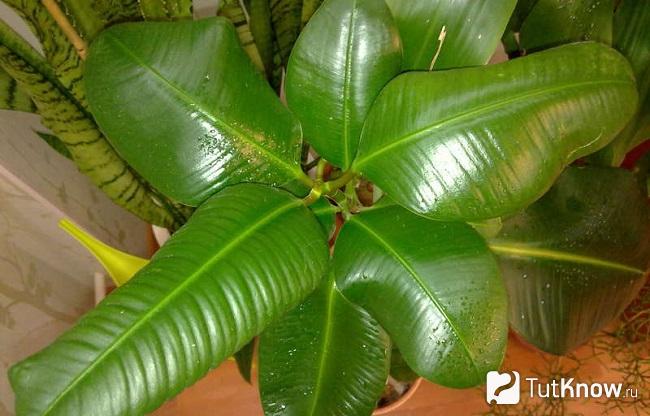

Elastic ficus has long been of industrial importance, since thick juice is a raw material for the production of rubber, but outside the tropical territories, the plant is used as an ornamental crop.
It must be remembered that some people have a negative reaction to the milky juice of ficus rubber, since they have skin intolerance in the form of allergies to latex, various enzymes and alkaloids. It can even cause dermatitis. Also, asthmatics have reactions in the form of asphyxiation, to the rubber that is released into the air.
The plant serves as a good filter, helping to purify the surrounding air from harmful compounds such as phenol, trichlorethylene and benzene. Elastic ficus has the property of converting such toxic substances into amino acids and sugars.
If we talk about the spiritual abilities of Ficus elastica, then adherents of the Ayurvedic teachings claim that the plant can help cleanse the room of the negative energy of anxiety and manifestations of anger. Also in India, they advised a couple who dreamed of having offspring to grow such a ficus in their home, and then children's laughter will certainly sound in the home.
According to studies carried out by medical professionals, the leaves of ficus rubber are raw materials for the manufacture of drugs that help in the treatment of mastopathy and contribute to the prevention of cancer, are applicable in the treatment of uterine fibroids and fibroids. If you use the juice of elastic fixer and make a compress on its basis, then with its help you can relieve the symptoms of sciatica, arthritis and also contribute to the treatment of hemorrhoids and osteochondrosis. If you use the milky juice of Ficus elastica, then you can heal wounds and cuts caused by animals or people.
It is interesting that on the territory of India, with the help of such plants, "living" suspension bridges are being built.
Ficus transplant
The transplant of rubber ficus should be carried out annually when it comes to a young plant, and at least once every 3 years when it comes to an adult plant. It is necessary to transplant the ficus as it grows. If the roots become cramped in the pot, then this is negatively reflected in the appearance of the flowerpot. It is also necessary to transplant ficus if the soil is excessively depleted and cannot give the plant all the substances necessary for life. And the depletion of the soil can be judged by how it absorbs water during watering. If a few moments after watering all the water is in the sump, then the soil needs to be replaced with a new one.
To make the plant feel comfortable, you need to choose the right soil. You can buy a ready-made substrate in a specialized store, or you can make it yourself. To prepare the soil at home, we need river sand, turf and peat land. All components are taken in equal amounts. During transplantation of rubber ficus, it is important not to damage its root system. It is necessary to carefully remove the plant, without shaking out the old soil from its roots. We carefully transfer the flower to a new pot, at the bottom of which a drainage layer has already been installed. Then, fill all the voids with new soil and water the plant. The new pot should be 5-6 cm larger both in width and height.
Before transplanting rubbery ficus, assess its condition. If the flowerpot is old and the transplant can negatively affect its condition, it is advisable to just partially replace the soil. To do this, remove the top layer 5-7 cm thick, and fill the plant with new soil.
Popular cultivars
The following varieties are usually chosen:
- Robusta. The easiest way to grow. The color is uniform, greenish.
- Belize. The edges are white or pink, the middle is emerald. Needs care.
- Black Prince. Undemanding type, distinguished by a burgundy shade.
- Tineke. An interesting variety with white-green dots on different sides. Quite moody, special supervision is required.
- Melanie. The smallest cultivar, the size of the leaf is no more than 20 cm. It bushes luxuriantly, forms a beautiful shape.
Attractiveness and life expectancy depend on various factors. Knowing how to properly care for a green pet can avoid many problems.


Illumination. Requests a large amount of bright diffused lighting, but block from sunlight, it will harm. Cover the window with tulle.
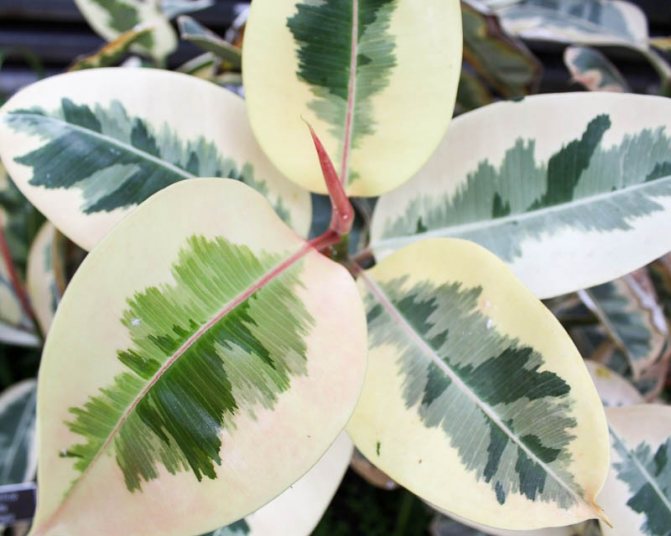

Compliance with temperature. In winter, it is optimal to withstand 18-20 degrees, but not lower than +15. From March to October, focus on + 20-25. Will not stand +30 for long.
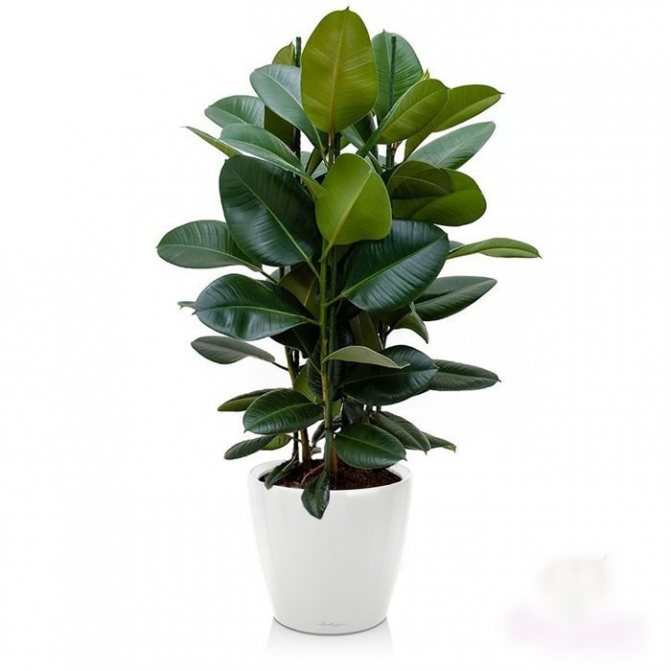

Remember: walking breezes and a sharp change in thermal regime are contraindicated.
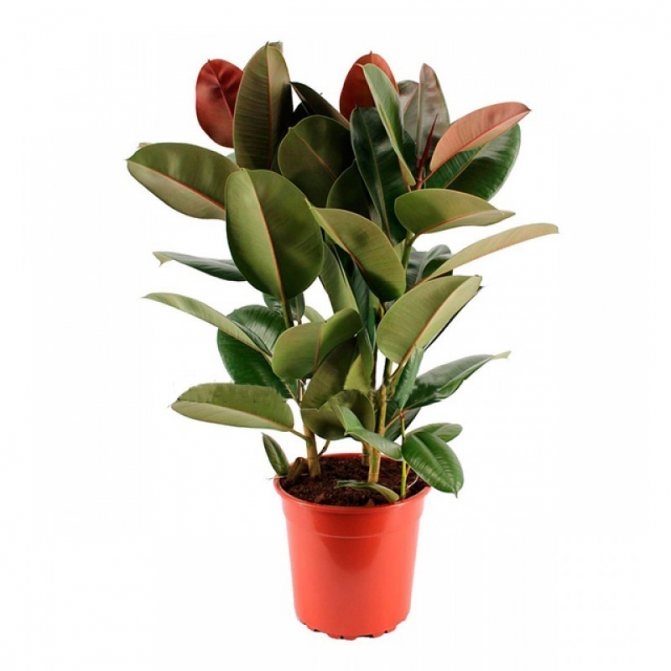

Watering. Watering is arranged every 3-4 days; in the cold, cut watering in half. Always feel the soil by touch; waterlogging will cause trouble.
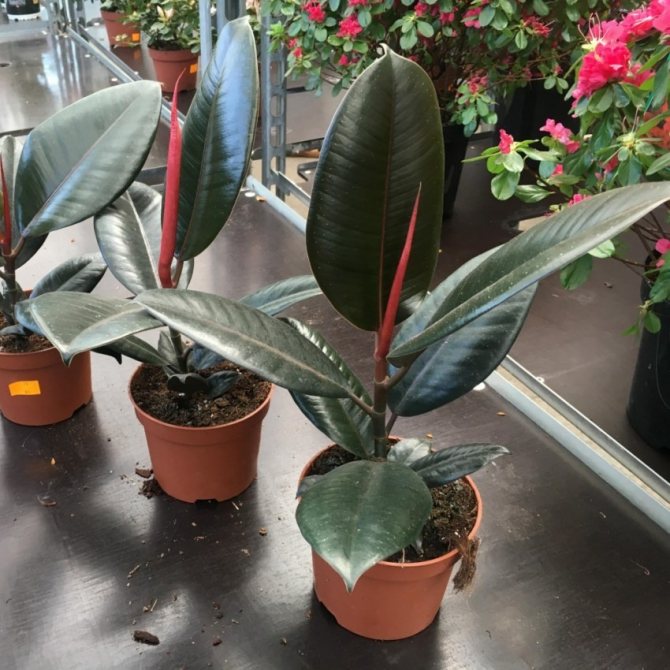

From April 2-3 times a month, walk over the bush with a wet rag, and also constantly spray on it. In winter, move it away from batteries and radiators: it will get used to dryness, but it will grow worse. Spraying is no longer necessary, just wipe.


Fertilizing the soil.Fertilize every two weeks, excluding November-February. Alternate between liquids containing organics and minerals. Any mixture requires nitrogen. Avoid contact with branches and buds to avoid burns.
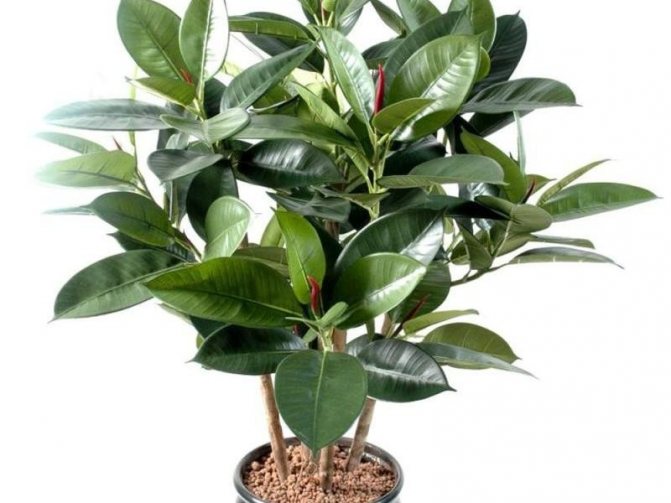

Use chemicals as little as possible to add gloss.
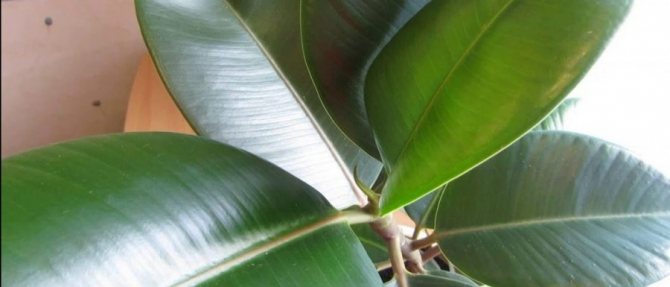

Transplanting. The transplant has its own characteristics. Youngsters are disturbed annually. If the soil dries up surprisingly quickly, or if you can see attempts to break through the drainage holes, then it's time.


For perennial trees, you can simply change the top 50 ml of the substrate, they may not tolerate the procedure and die. Therefore, transplant them no more than once every three years, when the sprouts completely cease to fit in the pot.


Note! Don't buy a very large container. The more spacious the root system feels, the more active the growth.


Good drainage is important, about 5 cm. Remove the bush without removing the clods from the rhizomes. Then fill up any voids until you fill it up completely.
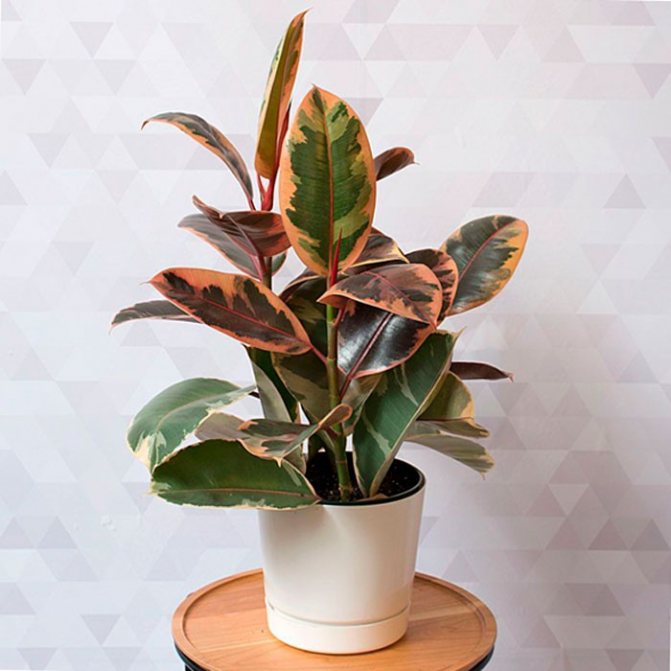

Cutting off the stems. Regular pruning is required to contain overgrowth and increase lushness. It is carried out in the spring, during the period of increased growth. At this time of the year, your ward will most painlessly endure the formation of the crown and will not lose the substances he needs.
A sharp knife, pre-treated with alcohol, is used for the operation. The protruding droplets are removed with a wet sponge.
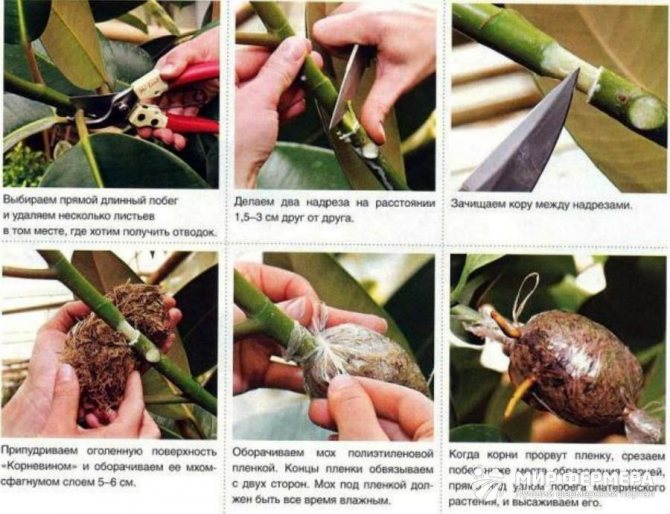

Reproduction of ficus
The flower propagates quite simply, so there is no point in looking for photos or video instructions on this topic. It is quite possible to dilute it at home, and not buy it in the store. Reproduction of rubbery ficus can be done in several ways:
- cuttings;
- reproduction by layering;
- leaf propagation.
Consider how you can multiply the rubber-bearing ficus in each way separately.
Cuttings
For propagation of rubber ficus by cuttings, you need to take part of the stem from an existing plant. It is best to pinch the top. Pinching is done with a sharp object (knife, blade). A part of the stem is taken, on average, 12 cm long. After pruning, and it must be done obliquely, we remove almost all the leaves. You need to pinch the part of the stem on which there are at least 2 leaves. If there are more leaves, then we leave only a couple of leaves located at the top of the cutting. Pruning must be done carefully so that the milky juice does not get on the skin. Then, thoroughly rinse the cut site under running water. After the milky juice has ceased to stand out, we place the cutting in a container with water. A glass or any other similar container is perfect.
To make the water evaporate as slowly as possible, we roll up the leaves that remain on the top of the cutting into a tube. You can fix the leaves with thin rubber bands. After the roots appear, we plant the cutting in the ground. You can plant a cutting immediately after pruning. In this case, it will take root faster. But, in the soil it is difficult to see whether the root system has appeared on the cuttings or not. When rooting into the soil on top of the cutting, you need to stretch the film. The rooting of the cuttings is fast enough.
Before planting the cuttings in the soil, you can treat the lower cut with drugs that stimulate the regrowth of roots. It is better to cut ficus in spring.
Reproduction by layering
Regardless of the variety of rubber ficus, it can be propagated by layering. But the easiest way to propagate in this way is a variegated variety of rubber ficus. We make an incision in the place where the aerial roots should grow. The depth of the notch should be one third of the volume of the trunk. In order to prevent the stem from growing together, we insert a piece of a toothpick or a match into the place of the incision. Then, wrap this place with moss and close it with a piece of bag. The entire structure can be secured with tape. It remains to wait for the flowerpot to take root and plant it in the soil.
Leaf propagation
In this case, you should cut off not only the leaf, but also a small part of the stem with it. It turns out, as it were, small cuttings. You need to choose a healthy-looking, preferably young leaf. Whatever type of rubber ficus you try to propagate, the leaf alone will never sprout, even though it gives roots and there is an opportunity to root it.
By and large, leaf propagation is not much different from cuttings. The leaf, as in the case of grafting, we plant it in the ground, after which we roll it up into a tube. We equip a mini greenhouse, covering the container with a film, and wait for the appearance of shoots.
How to propagate a rubbery ficus?
The plant is best propagated from late January to August:
- apical cuttings: the cuttings obtained as a result of pruning are washed from the escaping juice and placed in a container with water, which is periodically changed. After the formation of the roots, the plant is planted in a flowerpot;
- propagation by leaf or air layers: on a long shoot, choose a place located above the leaf. A vertical incision is made with a sharp knife, a match or a toothpick is inserted into it, this area is covered with wet sawdust or moss, and wrapped in plastic wrap. Two months later, roots appear, then the shoot is cut off and planted in a flowerpot.
Pruning and shaping the crown
In order for the plant to really become a decoration at home, you need to devote time to the formation of the crown of the rubber ficus. But before talking about the formation of rubber ficus, you should learn about pruning it. Pruning is done to keep the plant from growing. It is also needed to rejuvenate the plant. In addition, pruning contributes to the formation of a denser crown of the ficus tree. At the desired height, we cut off the top of the plant, which is fashionable to use as a cutting for its propagation.
To give the ficus the shape of a shrub, we plant the root top in a pot next to the parent plant. But we place it so that the plants grow beautifully, and do not crowd out each other. As a rule, 5 internodes are cut off. Therefore, before cutting off the top of the rubber-bearing ficus, count 5 internodes and see how much this plant height suits you. Ficus pruning is done only in early spring. If you do this at a different time, not the side shoots will begin to grow, but the top.
Before you form the crown of the plant, you need to imagine what shape you would like to see. If a lush bush is supposed, then at least 2 ficus should be planted in one pot. Do not be afraid that the bush will be too large. In addition, plants can always be planted. We form a bush during growth. To do this, we turn the pot so that the plants grow in all directions equally. Periodically pruning to branch out the flowerpot. As the ficus begins to bush, we correct the shape of the crown.
You can make a ficus branch in different ways. One of the ways to achieve the appearance of lateral processes involves bending the top of the ficus to the ground. In this case, the bud, which is at the highest point, gives rise to an escape. After the emergence of the shoot, we return the trunk to its original position. If necessary, the trunk must be tied up.
How to pinch a ficus
In order to pinch the plant, you will need a pruner or knife, a disinfectant solution (peroxide, alcohol), a soft napkin, and a container of water.
Then follow the instructions:
- It is best to perform the procedure in the middle of spring. It is during this period that many new shoots are formed, and the wounds on the trunk, which appear during pruning, quickly heal.
- Once the plant has reached the height you want, pinching can be done. Disinfect or heat a knife or other tool over a fire.
- If the top shoot of the tree is thin, you can cut it below the bud by making a straight cut.
- If the length is longer than you need, determine the required height, then find the sheet below that point. Cut the shoot 5 cm above such a leaf by making an oblique cut. The lower level of the cut will be at the level of the kidney on the opposite side. The upper one is directly above the kidney.
- Then moisten a soft napkin and remove the milky juice that appears along the cut.
- Fertilize the plant after a month. Before this period, feeding is not recommended, since the plant's immunity drops out after transplanting, it can be stressed.


Pinching will allow the plant to sprout new side shoots and stop growing at the height you want. Without this, the tree will hit the ceiling in 4-5 years.
Diseases and pests
Ficus cannot be called painful plants. It resists well both diseases and pests. However, from time to time, problems may arise that you need to be prepared for.
Ficus can be attacked by pests such as scale insects or spider mites. At the same time, the leaves dry and curl. If the sheet is twisted, then you need to unfold it and carefully examine it. Parasites are visible to the naked eye. When they appear, you need to immediately take measures so that you do not have to reanimate the flower later.
In addition to insecticides, which are in specialized stores, you can use tobacco dust diluted with soapy water to control pests. Add 4 tablespoons of tobacco dust to a liter of soapy water. With a cotton swab dipped in this liquid, wash all the leaves. After 2 hours, wash off the solution from the leaves of the ficus. Make sure there are no parasites left on the leaves of the plant after rinsing.
An adult bush is less susceptible to attack by pests than a young one.
We will not deal with the description of diseases in detail. Let's just say that the ficus is most susceptible to fungal diseases. Step-by-step treatment is as follows:
- remove all damaged parts of the flowerpot (you need to inspect and, if necessary, trim the roots);
- we treat the ficus with a fungicide.
Since the fungus can live in the ground, it will not be superfluous to transplant the plant, completely replacing the soil.
Problems associated with improper care
Signs of disease are yellowing and shedding of leaves. Often the plant is sick due to improper care. It is impossible to unequivocally answer the question of why the leaves of the rubber plant turn yellow. The reason may be either over-watering or lack of moisture, lack of light, or inappropriate regimen. Also, leaves can turn yellow from an overabundance of fertilizers or an excessive amount of salt in the soil, an unsuitable pot size and rotting roots. And the presence of drafts leads to the fact that dark spots first appear on the leaves, and then they turn black. Ficus leaves also darken at low temperatures.
It often happens that the ficus looks quite healthy, its leaves do not curl and do not change color to yellow, brown or brown spots do not appear and there are no other signs of the disease, but the flower has stopped growing. The reason that the ficus does not grow may be a lack of light or minerals. A pot that is too tight can also inhibit growth.
If the ficus has dropped the leaves or other symptoms of disease are found, you need to react without delay. Moreover, it will not be difficult to eliminate most of the problems at home. The first step is to change the conditions of detention. If the condition of the flowerpot did not improve, you should look for pests or determine the disease, and start treating it. If you delay the treatment, it will be difficult to save the flowerpot.
Plant care after pruning
After pruning, the ficus can be transplanted, but the procedure can be performed no earlier than 2 weeks later. An adult plant does not need to be transplanted at all; it will be enough to change the topsoil to a new nutrient substrate.If the flower has undergone the procedure successfully, after 2 weeks, you can start feeding.
You can carry out pruning no earlier than from the beginning of March until the end of summer. At rest, the plant is not pruned. Watch the growth of new branches, as well as the height of the ficus, carrying out timely pinching so that it always has a lush, uniform crown.
Useful properties and harm of ficus
If we talk about the dangers and benefits of rubber ficus, then we can come to the conclusion that the plant, when properly handled, is not dangerous. Despite the fact that the ficus is poisonous and can cause allergies, in the absence of contact with the sap of the plant, problems will not arise. There are various signs and superstitions that say, for example, that the ficus is able to drive men away from women. Therefore, in a house where there is an unmarried girl, it is undesirable to put a plant. But only the Slavs had a negative attitude towards this flower. The rest of the peoples have long kept ficuses of various varieties in their apartments, which absolutely did not prevent girls from getting married and building happy families.
Regardless of what kind of ficus we are talking about, and today there are so many of them that the table of contents of the book on the varieties of ficus takes several pages, this flower deserves attention. The beneficial properties of ficus, and it does not matter whether it is Belize or Abidjan, can be used in the treatment of certain diseases. This is not to say that the houseplant is actively used in traditional medicine, but folk healers often resort to its help. It is believed that the medicinal properties of the plant help get rid of mastopathy and reduce benign tumors. The use of ficus tinctures is justified in the treatment of hematomas, osteochondrosis, radiculitis, hemorrhoids and arthritis.
Description
In nature, it grows in a swampy shaded humid forest thicket in Nepal, Java, Bhutan, Sumatra, in the north-east of India.
Breeders have bred many varieties of rubbery ficus, but they do not grow in height like their wild ancestor.
The most popular varieties:
Abidjan
The leaves are characterized by a maroon shade.
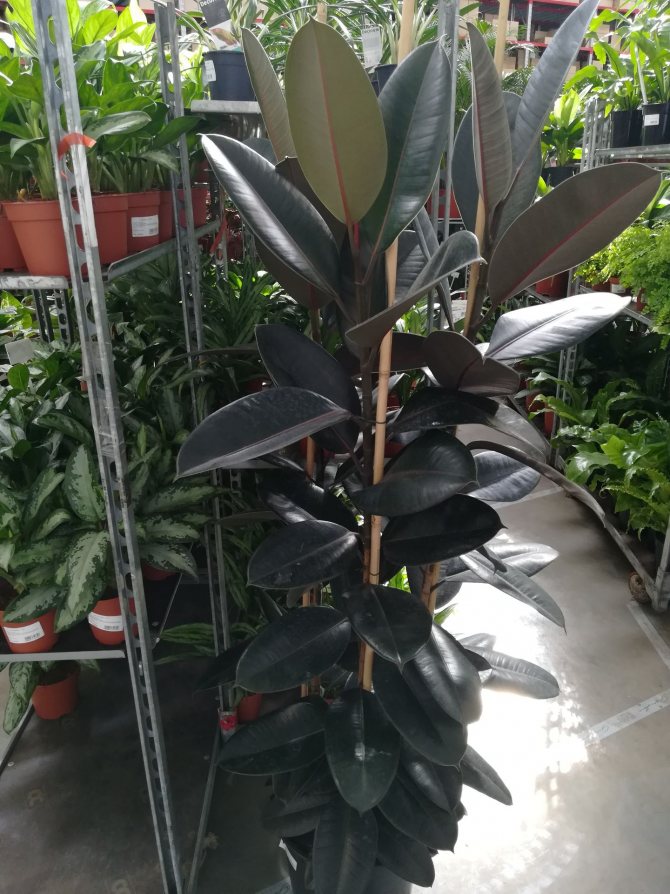

Abidjan
Black Prince
The color of the leaves is dark green (almost black), the leaf is about 26 cm long, 14 cm wide.
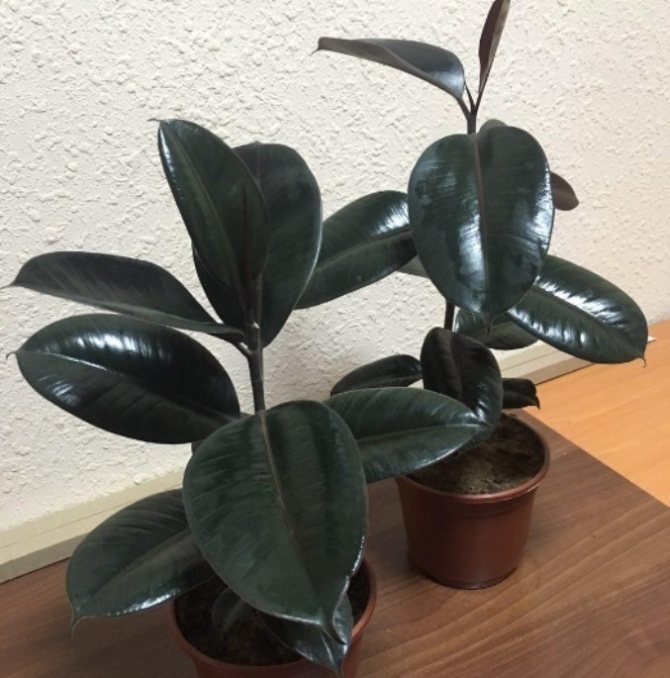

Black Prince
Belize
The leaf blades are characterized by a pink tint.


Belize
Doshery
Was withdrawn in 1925 (New Orleans). The leaves are narrow, grow up to 22 cm in length, up to 9 cm in width, are characterized by a striking color - a gray-green pattern on a cream background. In a well-lit area, the cap and midrib are pink, in a shaded area they are cream.
Tinike
Cream or gray-green spots on the edge of the leaf blade. The leaves grow up to 24 cm long and up to 14 cm wide.
Melanie
A miniature plant with dark leaves.
Robusta
Leaves are broad, intense green.
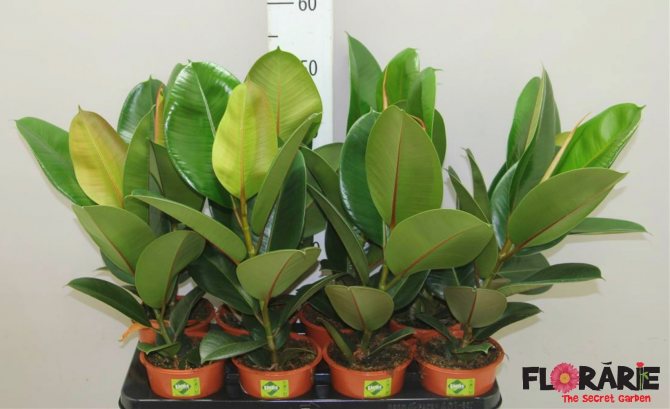

Robusta
Sriveriana
The variety was bred in 1959 (Belgium). The leaf blades are characterized by a light green color, interspersed with a green or gray tint, closer to the edge - yellow. The leaves grow in length up to 25 cm, in width up to 17 cm. The petioles are reddish.
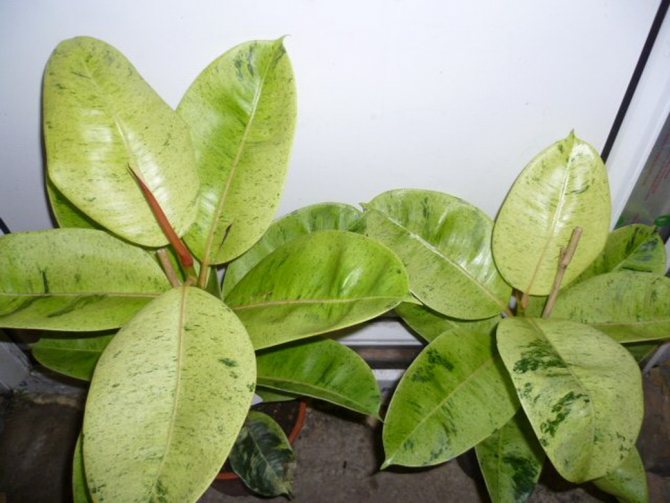

Sriveriana
In folk medicine, mixtures and tinctures are prepared from rubber-bearing ficus, which are used for mastopathy and for the prevention of cancer.
Since ancient times, there is a belief that this plant helps to improve the financial situation of its owner. Folk omens and superstitions claim that a tree helps a pregnant woman improve the process of carrying a child and makes childbirth easier.
Types of artificial ficus formation


With the help of shaping pruning, you can give the rubbery ficus several interesting shapes that will decorate the interior of any room:
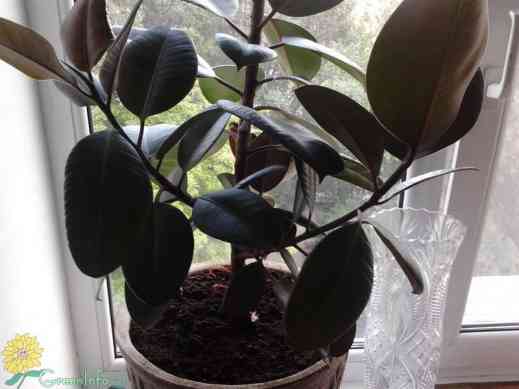

- The first way... To form a bush form, cut off the top of the central stem and all lateral shoots. The top is cut by 10-15 cm at a plant height of 70-75 cm.Lateral shoots are pinched when a length of 8-10 cm is reached.Deep pruning of the central stem stimulates the growth and development of lateral shoots and somewhat suspends the development of the central one. As a result, a cozy bush is formed, under which you can sit and meditate in the air free of microbes.
- Second way. A young plant in conditions of high humidity forms aerial roots, which are directed into the soil. As they take root, they form a banyan tree. With dense root formation, thinning is carried out, removing the roots and branches growing inward.
Stam


To form a stem in a single-stemmed young rubbery ficus, use its ability to grow upward. Leaves fall from below, exposing the stem. In the absence of natural exposure, the lower leaves and shoots are cut off to a height of 40 cm when the pot with a flower is located on a windowsill or other elevation and 90 cm when it is on the floor. The central stem is cut 10 cm, retarding its growth. Young side shoots are given priority in development. At the required height, the lateral branches are pinched (not cut off) onto the outer bud, making it possible to grow upwards parallel to the central stem and in turn branch out. It turns out a standard tree with a crown. In order for the crown to become spreading, there is a technique for forming lateral shoots with an arc.
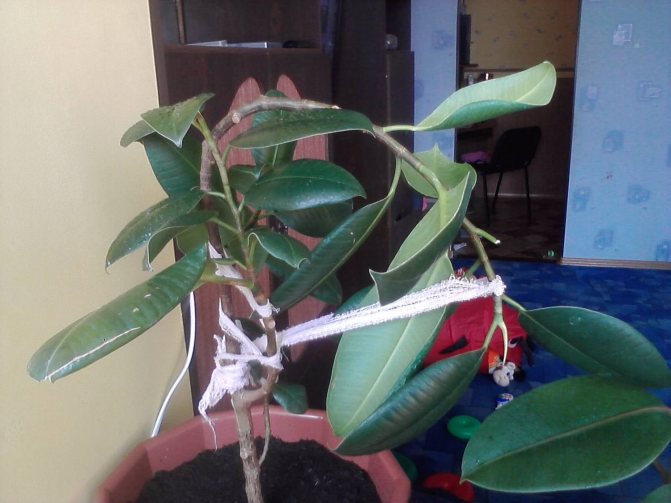

When the central stem reaches the required height, the top is cut off. At the same time, lateral shoots wake up. Ficus rubber grows mainly upward. To get a spreading crown with arched branches, it is necessary to bend the lateral shoots of a young plant and fix it in a bent position. In this case, the lateral buds of the upper side of the curved stem wake up and actively develop. When the lateral shoots reach the desired length, the fixation is removed. It turns out a spreading crown with arched branches on a trunk.
Decorative varieties of rubber ficus for home cultivation
Common rubbery ficus forms a dark green leafy mass. Breeders have developed decorative varieties with variegated leaves. Among them, the most famous in home culture:
- Ficus elastica ‘Decora’, whose young leaves have an unusual bronze color;
- Ficus elastica ‘Doescheri’, the variegation is unusually elegant, literally mesmerizing;
- Ficus elastica ‘Robusta’ with fancy green leaves;
- Ficus elastica Black Princ, with almost black leaves;
- Ficus elastica variegata, variegated leaf blades with cream edges and other patterns;
- Ficus elastica trikolor with variegated leaves.
What is famous for the genus "ficus" from the mulberry family
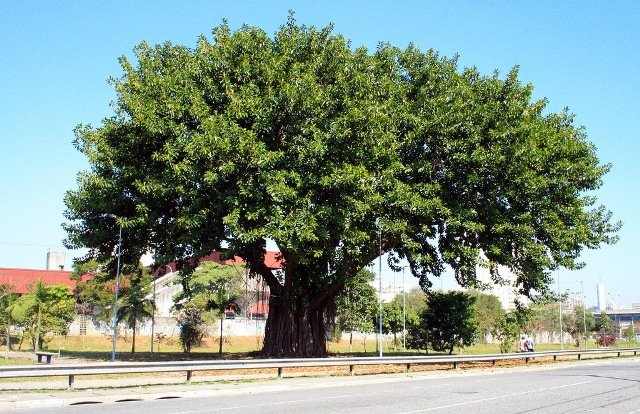

Ficus rubber in its natural environment
In enclosed spaces, rubber ficus is most common. Occupies an area limited by a tub or box and a space around no more than 1-2 meters in diameter. At home in the Indian jungle, the ficus genus is represented by a huge number of useful for aboriginal plants, from giant (under the shade of which more than 100 families can rest) to dwarfs in the form of miniature creeping shrubs. There are also strangler vines. Wrapping around trees, they grow into the master's trunks and strangle him "in love ecstasy."
For the first time, struck by the size of the ficus crown (in modern terms, about 300 m in circumference), this plant was described by the famous botanist Theophrastus more than 2000 years ago.
A closer acquaintance with the family surprises with its diversity and biological characteristics. In the amazing mulberry family, close relatives are:
- figs (fig tree, wine berry, fig, fig);
- mulberry (here, mulberry, king-berry);
- breadfruit (Jacques-tree with fruits weighing up to 20 kg);
- paper tree (the highest quality natural paper is made);
- cow tree (has the taste and nutritional value of milk);
- rubbery ficus (rubber tree, elastic or resilient ficus, contains 17.3% natural rubber);
- upas (anchar) is the most poisonous representative of the genus, perfectly described by A.S.Pushkin in the poem "Anchar".
Ficus forms
Crown formation is not easy, but what can your pet become as a result of such a procedure?
- Stamp. Your plant will look like a miniature tree. To do this, the stem is strengthened, and after a while the support is removed and the stem is cut by five centimeters. Then remove the lower branches and pinch the top. Form must be maintained.
- Fence. Place several ficuses next to each other and fasten them with threads. When the stems begin to connect with each other, it is necessary to remove the bark, wipe off the juice and fasten them with a film.
- Circular lattice. Everything, like last time, only the ficuses themselves are planted in a circle.
- Spiral. The barrel must be wrapped around the support. Often, ordinary wire is used as a frame. It is also necessary to remove all side branches.
- Original. You can put a coconut column in the center of the ficus composition. Over time, the roots of your ficuses will begin to braid the column, and the result of this process will be a single structure that looks like a banyan tree.






